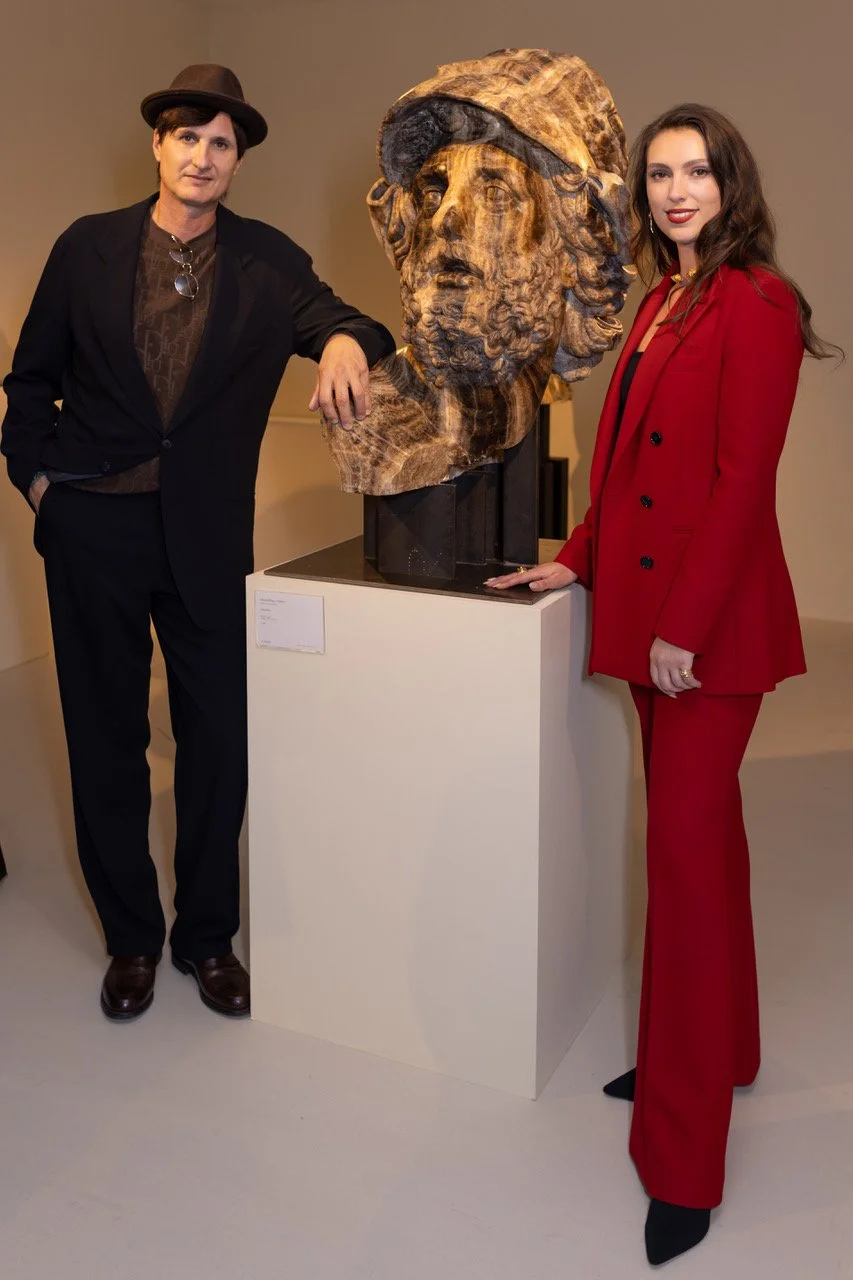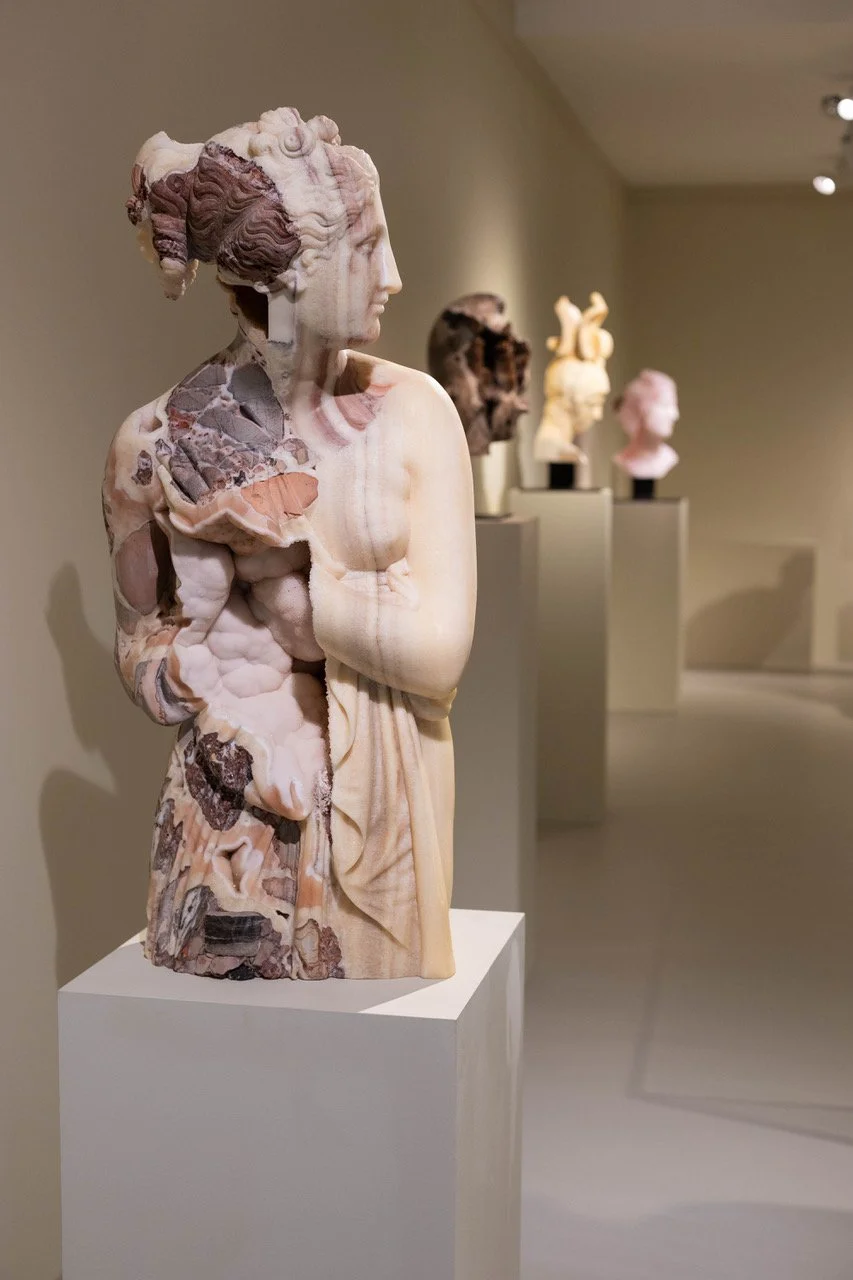Carving Time: The Enduring Art of Massimilano Pelletti
Photographer Twiggles / Courtesy of Bowman Sculpture
Some artists carve marble; others carve time. Massimiliano Pelletti does both chiselling not only form, but the fragile architecture of memory itself. When I met him at Bowman Sculpture, the room seemed charged with a quiet electricity, as though the ghosts of centuries stood still to watch. There is an aura about Pelletti, not the cultivated mystery of the contemporary art world, but something rarer, almost sacred. The air around him holds the same reverent weight one imagines surrounded Michelangelo at work: that rare convergence of discipline, devotion, and the divine.
To speak with Pelletti is to enter a slower current of time. He speaks with the composure of someone in conversation with eternity, revealing the contemplative labour behind his timeless forms, the paradox of permanence and fragility that defines both his practice and, perhaps, sculpture itself.
When you carve, do you already see the figure inside, or does it reveal itself as you work?
Quando scolpisci, vedi già la figura all’interno o ti si rivela man mano che lavori?
The creative process begins when I search for the material to sculpt, as it will play a very important role in the success of a work. I never start with the idea of wanting to represent a specific subject, but rather I look for stone materials that, through their special characteristics (cavities, fractures, surface marks, presence of micro-crystals), stimulate me and at the same time “suggest” the most suitable subjects to create within them. At that point, I choose the subject that I find most suitable for the block I have found from my gypsoteca, which consists of hundreds of ancient plaster models. The figure is already inside it and in my mind, it is now up to me to bring it out. I define my work as co-authorial because it is the result of a balance between my will and what the material, with its unexpected features and requirements, imposes on me to do.
L’atto creativo inizia nel momento in cui ricerco il materiale da scolpire, visto che esso ricoprirà un ruolo davvero molto importante nella riuscita di un’opera. Non parto mai dall’idea di voler rappresentare un determinato soggetto, bensì vado alla ricerca di materiali lapidei che attraverso le loro speciali caratteristiche (cavità, fratture, macchie della superficie, presenza di micro-cristalli) mi stimolino e allo stesso tempo mi “suggeriscano” i soggetti più adatti da realizzare al loro interno. A quel punto scelgo, dalla mia gipsoteca composta da centinaia di antichi modelli in gesso, il soggetto che trovo più adatto al blocco che ho trovato. La figura è già al suo interno e nella mia mente, sta a me ora tirarla fuori. Definisco il mio lavoro, coautoriale perché frutto dell’equilibrio tra le mie volontà e ciò che la materia con i suoi imprevisti e le sue esigenze mi impone di fare.
If one idea connects all your pieces in this exhibition, what would it be?
Se dovessi trovare un filo conduttore che collega tutte le tue opere in questa mostra, quale sarebbe?
This project is linked to the desire not to “reconstruct” the classic, but rather to transform it, allowing it to coexist with the natural imperfection of stone. The veins, cavities and fractures become part of the language, a metaphor for a vulnerable beauty that resists time precisely because of its wounds. In Metamorfosi myth, history and geology merge into a single sculptural organism: the work does not represent but reveals, as if the stone itself remembered what we have been and what we can still become.
Questo progetto è legato dalla volontà di non voler “ricostruire” il classico, bensì di trasformarlo, facendolo convivere con l’imperfezione naturale della pietra. Le venature, le cavità, le fratture diventano parte del linguaggio, metafora di una bellezza vulnerabile, che resiste al tempo proprio grazie alle ferite. In Metamorfosi, il mito, la storia e la geologia si fondono in un unico organismo scultoreo: l’opera non rappresenta ma rivela come se la pietra stessa ricordasse ciò che siamo stati e ciò che ancora possiamo diventare.
How do you want people to feel when they stand in front of your sculptures?
Cosa vorresti che provassero le persone quando si trovano davanti alle tue sculture? Today, in an era that requires us to rethink the measure of man and redefine his absolute role, I would like my works to remind us that the true power of art lies not in perfection, but in the ability to reveal fragility, limitations and transformations.
Through veined marble, fractures and grafts, I want to invite us to reconcile ourselves with materials and with time, accepting that identity is not an intact block, but a precarious balance that must always be rebuilt. This message is more necessary than ever today, in a world that is changing with speed and uncertainty, where authentic beauty is revealed precisely in our diversity and fragility.
Oggi, in un’epoca che impone di ripensare la misura dell’uomo e ridimensionarne il ruolo assoluto, vorrei che le mie opere ricordassero che la vera forza dell’arte non risiede nella perfezione, ma nella capacità di svelare fragilità, limiti e trasformazioni. Attraverso marmi venati, fratture, innesti, voglio invitare a riconciliarci con la materia e con il tempo accettando che l’identità non sia un blocco integro, ma un equilibrio precario, sempre da ricostruire. Un messaggio quanto mai necessario oggi, in un mondo che cambia con velocità ed incertezza, dove la bellezza autentica si rivela proprio nella nostra diversità e fragilità.


